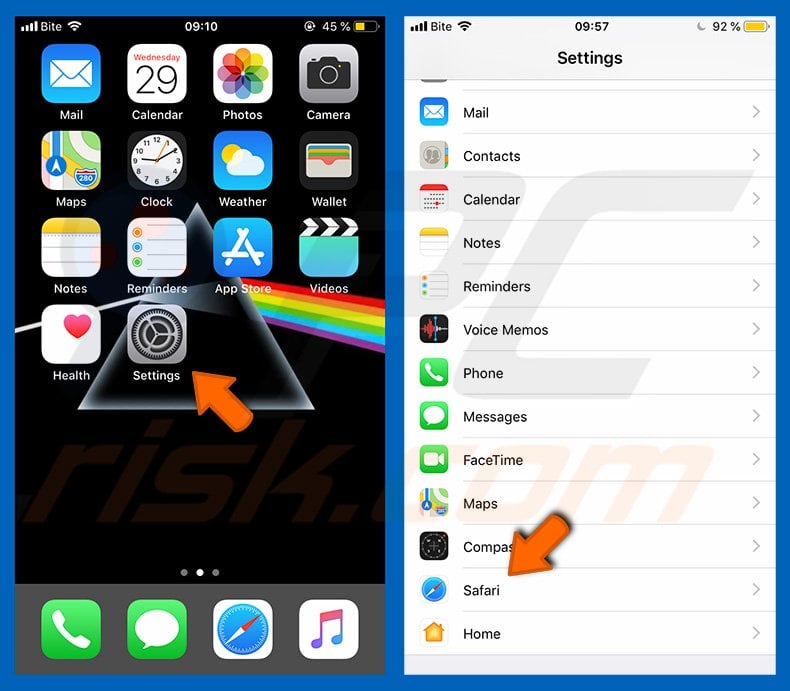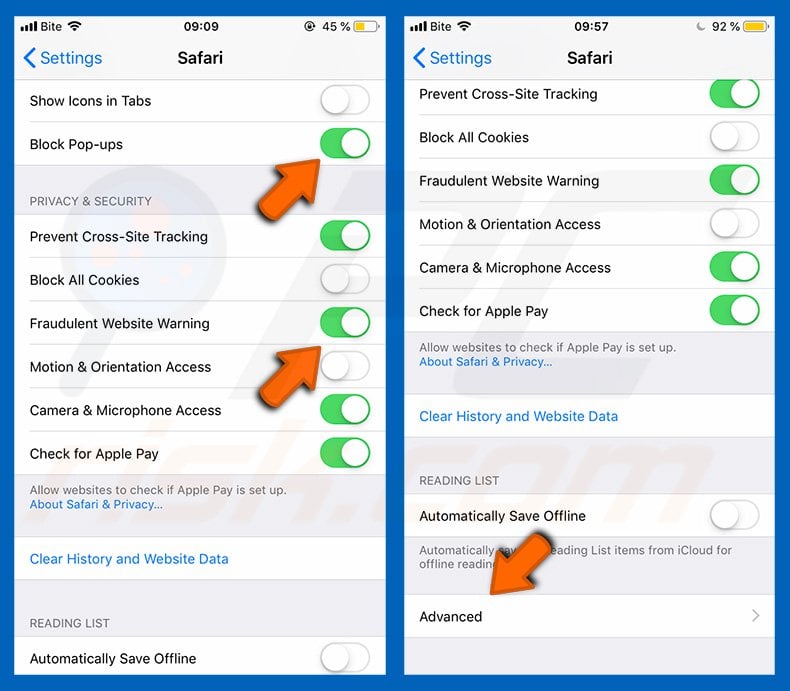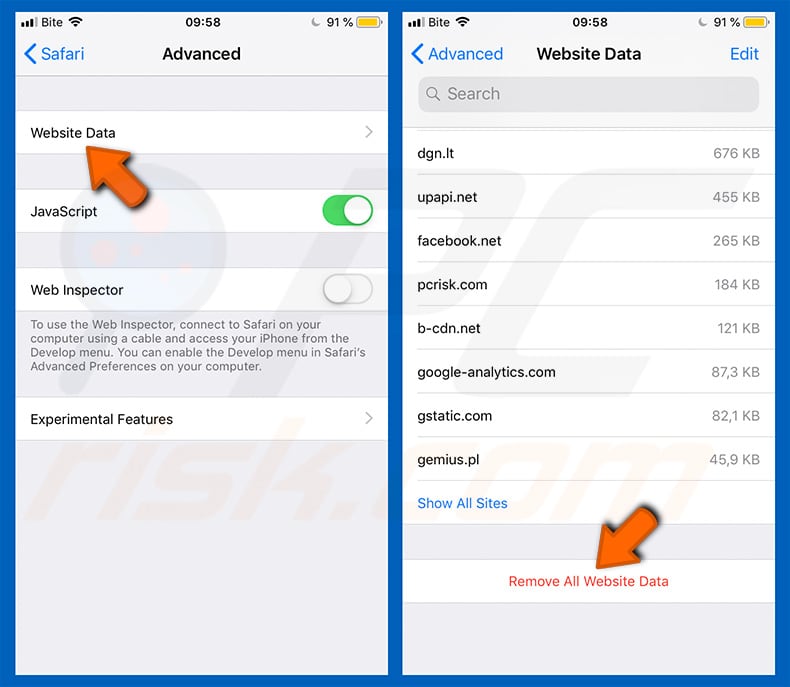Avoid getting scammed by content promoted on securecheckapp.com
Mac VirusAlso Known As: securecheckapp.com pop-up
Get free scan and check if your device is infected.
Remove it nowTo use full-featured product, you have to purchase a license for Combo Cleaner. Seven days free trial available. Combo Cleaner is owned and operated by RCS LT, the parent company of PCRisk.com.
What is securecheckapp[.]com?
Securecheckapp[.]com is an untrustworthy website designed to promote various scams. At the time of research, this page promoted a version of the "Your Apple iPhone is severely damaged" scheme. The scam primarily targets iPhone users, yet it might be accessed via other Apple devices.
This fake alert claims that users' mobile devices have been infected and damaged by multiple viruses. It must be emphasized that no site can detect threats or issues present on visitors' systems; hence, any that make such claims - are scams.
The goal of "Your Apple iPhone is severely damaged" and similar schemes is to endorse unreliable and possibly malicious software. Typically, these scams promote fake anti-virus tools, adware, browser hijackers, and other PUAs (Potentially Unwanted Applications).
It is noteworthy that schemes of this type have been used to proliferate malware (e.g., trojans, ransomware, etc.). Deceptive websites are seldom accessed intentionally; most users enter them via mistyped URLs, or redirects caused by intrusive advertisements or installed PUAs.
![securecheckapp[.]com scam](/images/stories/screenshots202104/securecheckapp-com-scam-main.jpg)
When the securecheckapp[.]com webpage is accessed, it displays a pop-up window. The text presented in it states that users' iPhones have been infected with six viruses. Should these threats remain within the device - they will damage the SIM card, delete stored contacts, and crash the phone as a result.
To remove the infections, the scam requests users to follow the following instructions. Once this pop-up is closed, the website shows another one. The message in it repeats the virus alert and urges to perform a system scan.
The text on the background page is a variant of the standard used for "Your Apple iPhone is severely damaged" scams. It informs victims that six nonexistent viruses have been found on users' iPhones.
The scheme elaborates that the infections are browser trojans and have damaged the browser (specified as Mobile Safari) to 45.4%. The origins of the hoax viruses are recently visited adult-themed websites.
The scam then lists potential threats the malware poses if not removed, e.g., unauthorized access and control over users' Facebook accounts, Whatsapp messenger, photos, and other private applications.
To remove the fake trojans, users are told to install the recommended application. Afterwards, they must open the app, activate the latest update, and remove any older (possibly infected) versions. As mentioned in the introduction, all of the information provided by securecheckapp[.]com - is false.
By trusting the content promoted on this page, users can experience system infections, serious privacy issues, financial losses, and even identity theft. PUAs are usually endorsed through online scams. These applications appear legitimate and offer various functionalities, which are rarely operational.
Fake anti-viruses are prime examples of this type of PUAs. They require activation (i.e., purchase) to have their features enabled, yet following activation - the functions remain nonoperational.
Furthermore, unwanted apps can have unmentioned, heinous abilities. Some types can force-open (cause redirects to) untrustworthy and malicious sites (e.g., securecheckapp[.]com). PUAs classified as adware run intrusive advertisement campaigns.
Once clicked on, intrusive adverts redirect to dangerous webpages, and may be able to download/install software stealthily. Another PUA type called browser hijacker operates by making changes to browser settings and restricting/denying access to them - in order to promote fake search engines.
The promoted web searchers rarely can provide search results, so they redirect to Google, Bing, Yahoo, and other legitimate search engines. What is more, most of these applications can track data.
Targeted information includes: browsing and search engine histories, IP addresses, geolocations, and personally identifiable details. The collected data is then shared with and/or sold to third-parties (potentially, cyber criminals). Therefore, it is crucial to remove suspicious software immediately upon detection.
| Name | securecheckapp.com pop-up |
| Threat Type | Phishing, Scam, Mac malware, Mac virus |
| Fake Claim | Scam claims that users' iPhones have been infected and damaged by viruses. |
| Promoted Unwanted Application | Various dubious applications |
| Serving IP Address | 67.227.226.240 |
| Symptoms | Your Mac becomes slower than normal, you see unwanted pop-up ads, you are redirected to dubious websites. |
| Distribution methods | Deceptive pop-up ads, free software installers (bundling), fake Flash Player installers, torrent file downloads. |
| Damage | Internet browser tracking (potential privacy issues), display of unwanted ads, redirects to dubious websites, loss of private information. |
| Malware Removal (Windows) |
To eliminate possible malware infections, scan your computer with legitimate antivirus software. Our security researchers recommend using Combo Cleaner. Download Combo CleanerTo use full-featured product, you have to purchase a license for Combo Cleaner. 7 days free trial available. Combo Cleaner is owned and operated by RCS LT, the parent company of PCRisk.com. |
Vpnservice[.]me, tackis[.]xyz, and security-info[.]space are a few examples of deceptive websites promoting iPhone-user targeting material. The Internet is rife with misleading and malicious content.
Popular scam models are: warnings that the device is infected, alerts that a piece of software is outdated or missing, fake prize raffles, ludicrous offers and deals, etc. The sole aim of online schemes is to generate revenue at victims' expense.
Due to how prevalent such sites are on the Web, it is strongly recommended to exercise caution when browsing.
How did potentially unwanted applications install on my computer?
Select PUAs have "official" promotional/download webpages. These applications are also distributed through downloaders/installers of other programs. This deceptive marketing method of packing ordinary software with unwanted or malicious additions - is termed "bundling".
Rushed download/installation processes (e.g., skipped steps and sections, used pre-set options, etc.) increase the risk of allowing bundled content into the system. Intrusive adverts proliferate PUAs as well. Upon being clicked, the ads can execute scripts to make downloads/installations without user permission.
How to avoid installation of potentially unwanted applications?
It is recommended to always research software products before download/installation and/or purchase. Only official and verified download channels must be used.
Untrustworthy sources, e.g., unofficial and free file-hosting websites, Peer-to-Peer sharing networks, and other third-party downloaders - commonly offer harmful and bundled content.
When downloading/installing, it is advised to read terms, study all possible options, use the "Custom/Advanced" settings and opt-out from additional apps, tools, features, etc.
Intrusive adverts appear legitimate and innocuous; however, they redirect to highly questionable sites (e.g., gambling, adult-dating, pornography, and many others).
In case of encounters with ads and/or redirects of this kind, the system must be checked and all suspect applications and browser extensions/plug-ins detected - removed from it without delay.
If your computer is already infected with PUAs, we recommend running a scan with Combo Cleaner Antivirus for Windows to automatically eliminate them.
Text presented in the initial pop-up window displayed on securecheckapp[.]com:
Your Apple iPhone is infected by (6) viruses.
If not resolved immediately, the virus will crash your cell phone, damage the SIM card and delete all your contacts.
Follow the instructions below to remove the virus.
Close
Appearance of the "Your Apple iPhone is severely damaged" scam variant run on securecheckapp[.]com:
![Variant of the Your Apple iPhone is severely damaged scam promoted on securecheckapp[.]com](/images/stories/screenshots202001/securecheckapp-com-scam-alternative-variant.jpg)
Text presented in this scam variant:
Pop-up:
Virus Warning!
Your Apple iPhone has been infected with potential virus!
Click the OK button to scan your phone now
OK
------------------------
Background:
Warning
Your Apple iPhone is severely damaged by (6) viruses!
We have detected that your Mobile Safari is (45.4%) DAMAGED by BROWSER TROJAN VIRUS picked up while surfing recent adult sites.
Immediate action is required to prevent it from spreading and infecting sensitive data like your Facebook account, Whatsapp messages photos and private applications
REMOVE VIRUS
Step 1: Tap REMOVE VIRUS to install My Mobile Secure from the App Store.
Step 2: Open the application to activate the latest update and remove any older (Infected) versions.
To enable pop-up blocking, fraudulent website warnings, and remove web browsing data in mobile Apple devices, follow these steps:
First, go to "Settings", and then scroll down to find and tap "Safari".

Check if the "Block Pop-ups" and "Fraudulent Website Warning" toggles are enabled. If not, enable them immediately. Then, scroll down and tap "Advanced".

Tap "Website Data" and then "Remove All Website Data".

Instant automatic malware removal:
Manual threat removal might be a lengthy and complicated process that requires advanced IT skills. Combo Cleaner is a professional automatic malware removal tool that is recommended to get rid of malware. Download it by clicking the button below:
DOWNLOAD Combo CleanerBy downloading any software listed on this website you agree to our Privacy Policy and Terms of Use. To use full-featured product, you have to purchase a license for Combo Cleaner. 7 days free trial available. Combo Cleaner is owned and operated by RCS LT, the parent company of PCRisk.com.
Quick menu:
- What is "securecheckapp[.]com"?
- STEP 1. Remove PUA related files and folders from OSX.
- STEP 2. Remove rogue extensions from Safari.
- STEP 3. Remove rogue add-ons from Google Chrome.
- STEP 4. Remove potentially unwanted plug-ins from Mozilla Firefox.
Video showing how to remove adware and browser hijackers from a Mac computer:
Potentially unwanted applications removal:
Remove potentially unwanted applications from your "Applications" folder:

Click the Finder icon. In the Finder window, select "Applications". In the applications folder, look for "MPlayerX","NicePlayer", or other suspicious applications and drag them to the Trash. After removing the potentially unwanted application(s) that cause online ads, scan your Mac for any remaining unwanted components.
DOWNLOAD remover for malware infections
Combo Cleaner checks if your computer is infected with malware. To use full-featured product, you have to purchase a license for Combo Cleaner. 7 days free trial available. Combo Cleaner is owned and operated by RCS LT, the parent company of PCRisk.com.
Remove adware-related files and folders

Click the Finder icon, from the menu bar. Choose Go, and click Go to Folder...
 Check for adware generated files in the /Library/LaunchAgents/ folder:
Check for adware generated files in the /Library/LaunchAgents/ folder:

In the Go to Folder... bar, type: /Library/LaunchAgents/

In the "LaunchAgents" folder, look for any recently-added suspicious files and move them to the Trash. Examples of files generated by adware - "installmac.AppRemoval.plist", "myppes.download.plist", "mykotlerino.ltvbit.plist", "kuklorest.update.plist", etc. Adware commonly installs several files with the exact same string.
 Check for adware generated files in the ~/Library/Application Support/ folder:
Check for adware generated files in the ~/Library/Application Support/ folder:

In the Go to Folder... bar, type: ~/Library/Application Support/

In the "Application Support" folder, look for any recently-added suspicious folders. For example, "MplayerX" or "NicePlayer", and move these folders to the Trash.
 Check for adware generated files in the ~/Library/LaunchAgents/ folder:
Check for adware generated files in the ~/Library/LaunchAgents/ folder:

In the Go to Folder... bar, type: ~/Library/LaunchAgents/

In the "LaunchAgents" folder, look for any recently-added suspicious files and move them to the Trash. Examples of files generated by adware - "installmac.AppRemoval.plist", "myppes.download.plist", "mykotlerino.ltvbit.plist", "kuklorest.update.plist", etc. Adware commonly installs several files with the exact same string.
 Check for adware generated files in the /Library/LaunchDaemons/ folder:
Check for adware generated files in the /Library/LaunchDaemons/ folder:

In the "Go to Folder..." bar, type: /Library/LaunchDaemons/

In the "LaunchDaemons" folder, look for recently-added suspicious files. For example "com.aoudad.net-preferences.plist", "com.myppes.net-preferences.plist", "com.kuklorest.net-preferences.plist", "com.avickUpd.plist", etc., and move them to the Trash.
 Scan your Mac with Combo Cleaner:
Scan your Mac with Combo Cleaner:
If you have followed all the steps correctly, your Mac should be clean of infections. To ensure your system is not infected, run a scan with Combo Cleaner Antivirus. Download it HERE. After downloading the file, double click combocleaner.dmg installer. In the opened window, drag and drop the Combo Cleaner icon on top of the Applications icon. Now open your launchpad and click on the Combo Cleaner icon. Wait until Combo Cleaner updates its virus definition database and click the "Start Combo Scan" button.

Combo Cleaner will scan your Mac for malware infections. If the antivirus scan displays "no threats found" - this means that you can continue with the removal guide; otherwise, it's recommended to remove any found infections before continuing.

After removing files and folders generated by the adware, continue to remove rogue extensions from your Internet browsers.
Remove malicious extensions from Internet browsers
 Remove malicious Safari extensions:
Remove malicious Safari extensions:

Open the Safari browser, from the menu bar, select "Safari" and click "Preferences...".

In the preferences window, select "Extensions" and look for any recently-installed suspicious extensions. When located, click the "Uninstall" button next to it/them. Note that you can safely uninstall all extensions from your Safari browser - none are crucial for regular browser operation.
- If you continue to have problems with browser redirects and unwanted advertisements - Reset Safari.
 Remove malicious extensions from Google Chrome:
Remove malicious extensions from Google Chrome:

Click the Chrome menu icon ![]() (at the top right corner of Google Chrome), select "More Tools" and click "Extensions". Locate all recently-installed suspicious extensions, select these entries and click "Remove".
(at the top right corner of Google Chrome), select "More Tools" and click "Extensions". Locate all recently-installed suspicious extensions, select these entries and click "Remove".

- If you continue to have problems with browser redirects and unwanted advertisements - Reset Google Chrome.
 Remove malicious extensions from Mozilla Firefox:
Remove malicious extensions from Mozilla Firefox:

Click the Firefox menu ![]() (at the top right corner of the main window) and select "Add-ons and themes". Click "Extensions", in the opened window locate all recently-installed suspicious extensions, click on the three dots and then click "Remove".
(at the top right corner of the main window) and select "Add-ons and themes". Click "Extensions", in the opened window locate all recently-installed suspicious extensions, click on the three dots and then click "Remove".

- If you continue to have problems with browser redirects and unwanted advertisements - Reset Mozilla Firefox.
Share:

Tomas Meskauskas
Expert security researcher, professional malware analyst
I am passionate about computer security and technology. I have an experience of over 10 years working in various companies related to computer technical issue solving and Internet security. I have been working as an author and editor for pcrisk.com since 2010. Follow me on Twitter and LinkedIn to stay informed about the latest online security threats.
PCrisk security portal is brought by a company RCS LT.
Joined forces of security researchers help educate computer users about the latest online security threats. More information about the company RCS LT.
Our malware removal guides are free. However, if you want to support us you can send us a donation.
DonatePCrisk security portal is brought by a company RCS LT.
Joined forces of security researchers help educate computer users about the latest online security threats. More information about the company RCS LT.
Our malware removal guides are free. However, if you want to support us you can send us a donation.
Donate
▼ Show Discussion